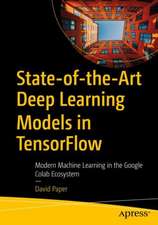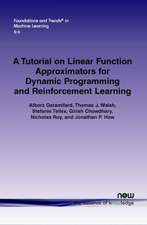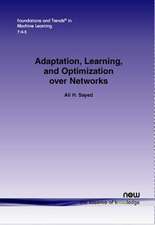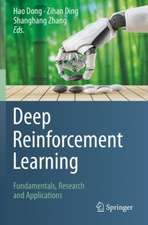Advanced Forecasting with Python: With State-of-the-Art-Models Including LSTMs, Facebook’s Prophet, and Amazon’s DeepAR
Autor Joos Korstanjeen Limba Engleză Paperback – 3 iul 2021
Rather than focus on a specific set of models, this book presents an exhaustive overview of all the techniques relevant to practitioners of forecasting. It begins by explaining the different categories of models that are relevant for forecasting in a high-level language. Next, it covers univariate and multivariate time series models followed by advanced machine learning and deep learning models. It concludes with reflections on model selection such as benchmark scores vs. understandability of models vs. compute time, and automated retraining and updating of models.
Each of the models presented in this book is covered in depth, with an intuitive simple explanation ofthe model, a mathematical transcription of the idea, and Python code that applies the model to an example data set.
Reading this book will add a competitive edge to your current forecasting skillset. The book is also adapted to those who have recently started working on forecasting tasks and are looking for an exhaustive book that allows them to start with traditional models and gradually move into more and more advanced models.
What You Will Learn
- Carry out forecasting with Python
- Mathematically and intuitively understand traditional forecasting models and state-of-the-art machine learning techniques
- Gain the basics of forecasting and machine learning, including evaluation of models, cross-validation, and back testing
- Select the right model for the right use case
The advanced nature of the later chapters makes the book relevant for appliedexperts working in the domain of forecasting, as the models covered have been published only recently. Experts working in the domain will want to update their skills as traditional models are regularly being outperformed by newer models.
Preț: 263.34 lei
Preț vechi: 329.18 lei
-20% Nou
Puncte Express: 395
Preț estimativ în valută:
50.40€ • 52.42$ • 41.61£
50.40€ • 52.42$ • 41.61£
Carte disponibilă
Livrare economică 24 martie-07 aprilie
Livrare express 08-14 martie pentru 110.56 lei
Preluare comenzi: 021 569.72.76
Specificații
ISBN-13: 9781484271490
ISBN-10: 1484271491
Pagini: 296
Ilustrații: XVII, 296 p. 106 illus., 36 illus. in color.
Dimensiuni: 178 x 254 x 22 mm
Greutate: 0.55 kg
Ediția:1st ed.
Editura: Apress
Colecția Apress
Locul publicării:Berkeley, CA, United States
ISBN-10: 1484271491
Pagini: 296
Ilustrații: XVII, 296 p. 106 illus., 36 illus. in color.
Dimensiuni: 178 x 254 x 22 mm
Greutate: 0.55 kg
Ediția:1st ed.
Editura: Apress
Colecția Apress
Locul publicării:Berkeley, CA, United States
Cuprins
Chapter 1: Models for Forecasting.- Chapter 2: Model Evaluation for Forecasting.- Chapter 3: The AR Model.- Chapter 4: The MA model.- Chapter 5: The ARMA model.- Chapter 6: The ARIMA model.- Chapter 7: The SARIMA Model.- Chapter 8: The VAR model.- Chapter 9: The Bayesian VAR model.- Chapter 10: The Linear Regression model.- Chapter 11: The Decision Tree model.- Chapter 12: The k-Nearest Neighbors VAR model.- Chapter 13: The Random Forest Model.- Chapter 14: The XGBoost model.- Chapter 15: The Neural Network model.- Chapter 16: Recurrent Neural Networks.- Chapter 17: LSTMs.- Chapter 18: Facebook’s Prophet model.- Chapter 19: Amazon’s DeepAR Model.- Chapter 20: Deep State Space Models.- Chapter 21: Model selection.
Notă biografică
Joos is a data scientist, with over five years of industry experience in developing machine learning tools, of which a large part is forecasting models. He currently works at Disneyland Paris where he develops machine learning for a variety of tools. His experience in writing and teaching have motivated him to make this book on advanced forecasting with Python.
Textul de pe ultima copertă
Cover all the machine learning techniques relevant for forecasting problems, ranging from univariate and multivariate time series to supervised learning, to state-of-the-art deep forecasting models such as LSTMs, recurrent neural networks, Facebook’s open-source Prophet model, and Amazon’s DeepAR model.
Rather than focus on a specific set of models, this book presents an exhaustive overview of all the techniques relevant to practitioners of forecasting. It begins by explaining the different categories of models that are relevant for forecasting in a high-level language. Next, it covers univariate and multivariate time series models followed by advanced machine learning and deep learning models. It concludes with reflections on model selection such as benchmark scores vs. understandability of models vs. compute time, and automated retraining and updating of models.
Each of the models presented in this book is covered in depth, with an intuitive simple explanation of the model, amathematical transcription of the idea, and Python code that applies the model to an example data set.
Reading this book will add a competitive edge to your current forecasting skillset. The book is also adapted to those who have recently started working on forecasting tasks and are looking for an exhaustive book that allows them to start with traditional models and gradually move into more and more advanced models.
You will:
Each of the models presented in this book is covered in depth, with an intuitive simple explanation of the model, amathematical transcription of the idea, and Python code that applies the model to an example data set.
Reading this book will add a competitive edge to your current forecasting skillset. The book is also adapted to those who have recently started working on forecasting tasks and are looking for an exhaustive book that allows them to start with traditional models and gradually move into more and more advanced models.
You will:
- Carry out forecasting with Python
- Mathematically and intuitively understand traditional forecasting models and state-of-the-art machine learning techniques
- Gain the basics of forecasting and machine learning, including evaluation of models, cross-validation, and back testing
- Select the right model for the right use case
Caracteristici
Covers state-of-the-art-models including LSTMs, Facebook’s Prophet, and Amazon’s DeepAR Includes an exhaustive overview of models relevant to forecasting Provides intuitive explanations, mathematical background, and applied examples in Python for each of the 18 models covered



























